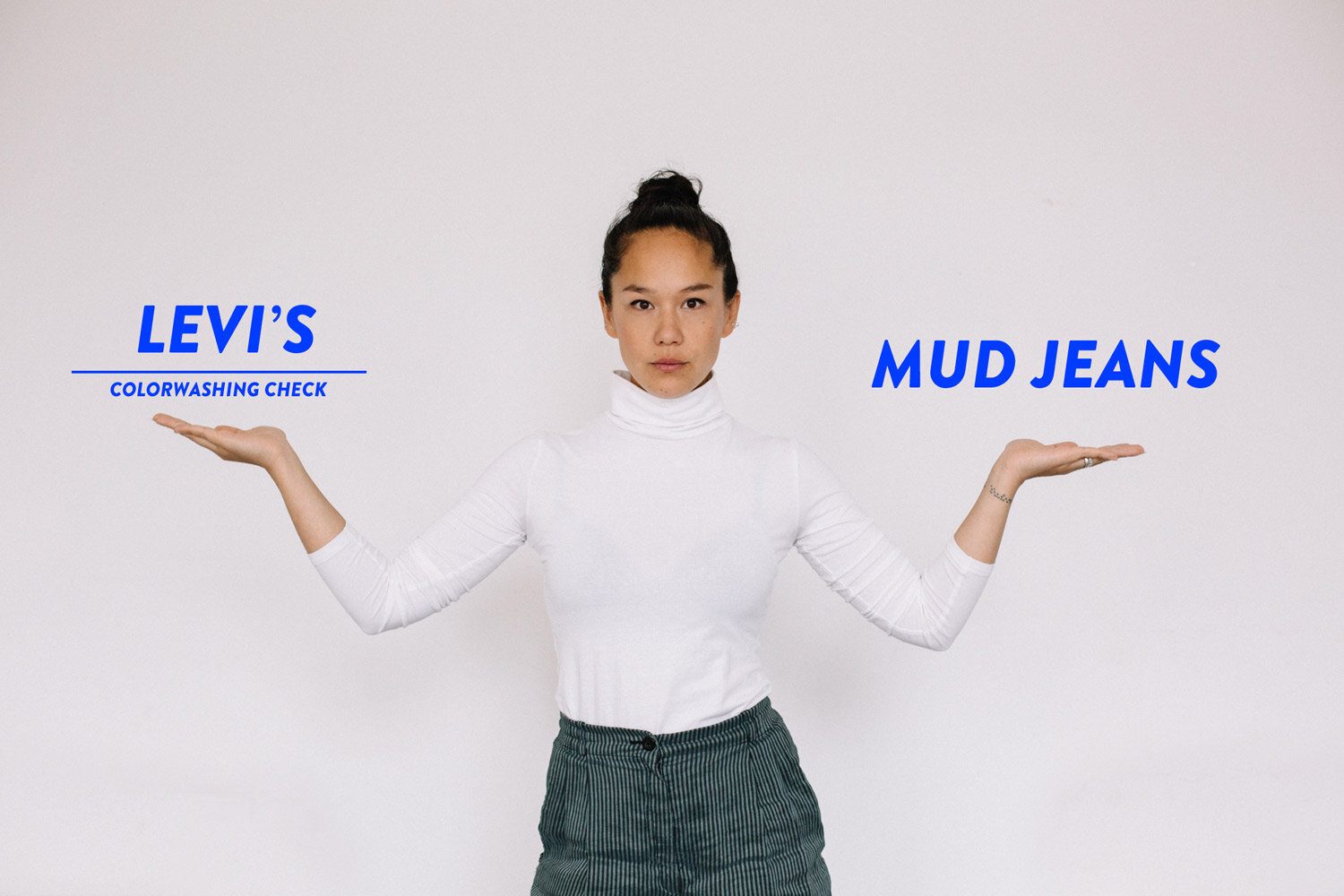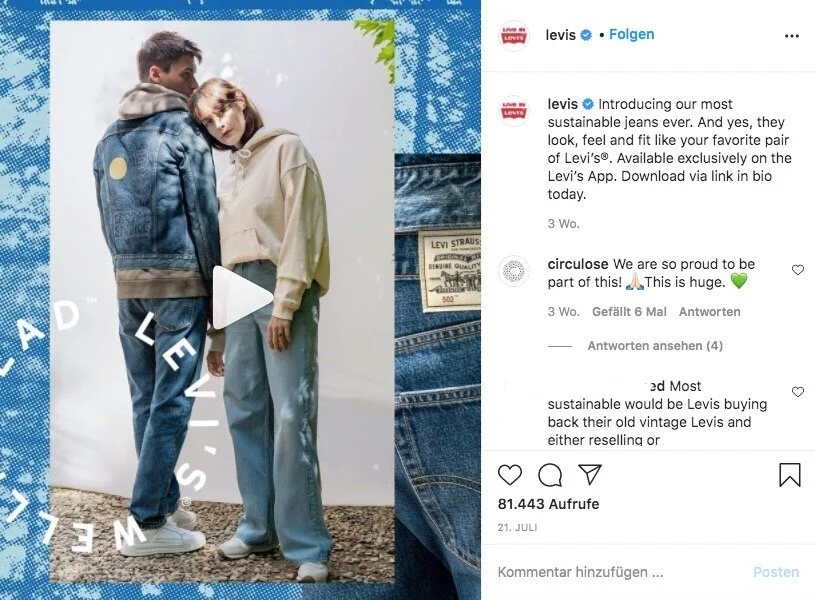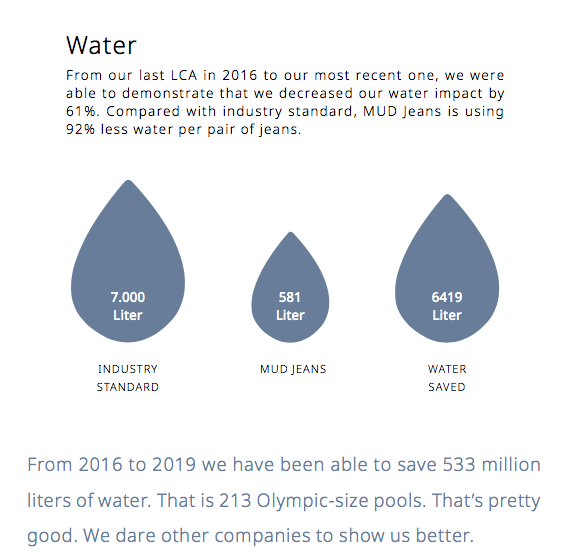“Levi's Launches Its Most Sustainable Jeans Ever”
When the company that invented one of our favorite pieces of clothing says it launched “its most sustainable jeans ever”, then that sounds like great news. Especially because the process to create the fabric (denim) is one of the most water-intensive processes in the textile industry.
According to Greenpeace, it takes 7,000 liters of water to make a pair of jeans, from the production of the cotton to the delivery to the store. [1].
So what exactly is the deal behind the headline? Is Levi’s living up to the expectation such a message implies? Or is the brand rather luring consumers into believing they’re doing so?
On my way to find an answer and to put Levi’s sustainability efforts into perspective, I chose to compare it to their competitor MUD jeans, a denim brand that is known to pioneer the sustainable jeans space.
BRAND ACTIVITY
On 21st July Levi’s introduced their “most sustainable jeans” ever:
The brand commented: “We teamed up with Re:newcell, who developed a recycling technology that would help us make new jeans from old denim. The process is pretty simple — although it does involve a couple of machines that slurry fibers to a pulp called Circulose®. By implementing the technology, we’re able to “close the loop” in our supply chain, which means we can keep making new products from used garments. In addition to curbing landfill waste, this recycled denim helps decrease our water and chemical usage and reduce our CO2 footprint.” [2]
THE CLOSE-UP
What does “most sustainable jeans” exactly mean in Levi’s terms? On what metrics is that claim based on? The brand unfortunately does not provide much info except for three indicators. Their jeans are made from:
20% recycled denim
20% sustainably sourced viscose and
60% organic cotton
The website doesn’t say much more and upon asking the brand directly via facebook if it could provide more info, it hasn’t replied at all.
Furthermore, when searching Levi’s website and their sustainability section, the brand says to have a “straightforward” understanding of sustainability but in fact, the explanation is very vague:
“For us at Levi’s®, it’s about making better choices like sourcing more sustainable materials and finding ways to use less water. It’s about making better clothes like WellThread™, our most sustainably designed collection. And it’s about bettering the planet and the communities that share it at every step along the way.” [3]
Also their strategy to reduce their environmental impact isn’t transparent. Levi’s says to have saved more than 3.5 billion liters of water from the finishing process since 2010” but the brand does not disclose how it compares to the amount of water they used in the first place. As a reader, I think 3.5 billion liters is a lot but how should I know if that’s true or more like a drop in the ocean?
I’m suspicious when a brand’s communication exclusively relies on “flagshipping” its best numbers while avoiding to speak about the overall environmental and social impact. Levi’s also doesn’t report on its sustainability efforts. Speaking about sustainability goes hand in hand with accountability and transparency, otherwise it’s most likely greenwashing. In this case, publishing a sustainability report would be a great next step.
So here’s my attempt to put the number (3.5 billion liters) into perspective: Levi’s reported to have had $ 48 billion in sales over the last 10 years [4]. I assume that at least 30% of its turnover results from selling jeans at an average price point of $ 50 each (factoring in wholesale prices). That means Levi’s has produced 288 million jeans in 10 years, equivalent to having used roughly 2016 billion liters of water.
If the number were to be right, 3.5 billion liters is like the drop in the ocean. It’s 0,17% of the overall water used in the process of producing that many jeans.
For MUD Jeans, for example, keeping environmental impact at a minimum while ensuring good working conditions is at the core of the business rather than a strategy. Among other measures, the brand implemented a “Lease-A-Jeans” model, a repair service and offer to take back old, worn jeans while upcycling and re-selling them as well. Most importantly, the system in place applies to all products and not just to one single collection.
Comparing water usage, MUD Jeans shows how to transparently communicate and enabling consumers to understand the proportions better:
This is how MUD Jeans talks about its water footprint: “To produce one pair of MUD Jeans we use 577 litres of water, compared to an industry standard of 7,000 litres per jeans. So with every jeans purchased you save 6,423 litres of water. ” [5]
See the difference?
CONCLUSION
Levi’s communications team did well to say it’s their most sustainable jeans ever, referring to their own standards. No one can prove them wrong. But, I wonder “what’s to come next”? Their most, most sustainable jeans? Isn’t “sustainability” an ongoing, virtually infinite process?
And can a product really be sustainable when it is not addressing social issues? Can it be considered sustainable when a brand does not practice transparency? Is using the term “sustainable” based on a vague understanding of its underlying metrics already greenwashing?
My conclusion is that Levi’s message is not greenwashing per se. But I am giving a few points for all the implications such a message conveys while their sustainability standards are not clear.
For sake of better communication, transparency and accountability I call Levi’s to take sustainability to full account by publishing a dedicated sustainability report in the future.
KARRY’S COLORWASHING SCORE:
4/10
Sources:
[1] https://www.sustainablefashionmatterz.com/fashion-facts
[2] https://www.levi.com/DE/en/features/wellthread
[3] https://www.levi.com/DE/en/features/sustainability
[4] https://de.statista.com/statistik/daten/studie/159216/umfrage/levi-strauss---nettoumsatz-seit-2005
[5] https://mudjeans.eu/blog-sustainability-report-impact/













The Guardian recently published an article stating that “Renting clothes is less green than throwing them away”. The article is based on a study by IOP science which came to multiple conclusions, one of which ranked Rental as the most GWP (Global Warming Potential) in comparison to … READ MORE